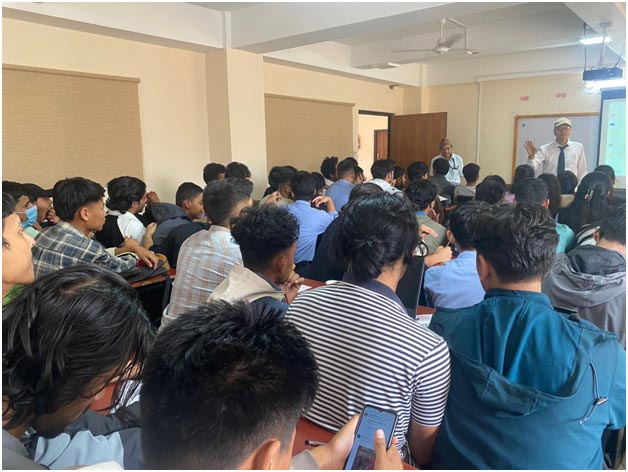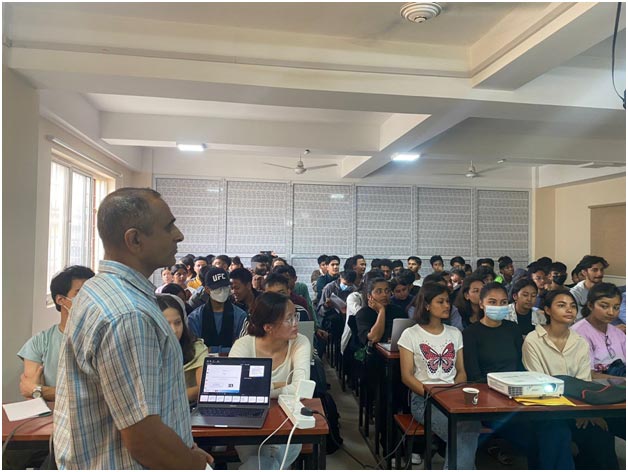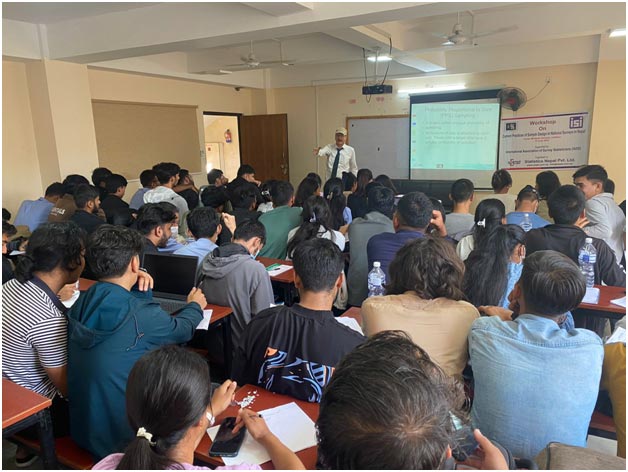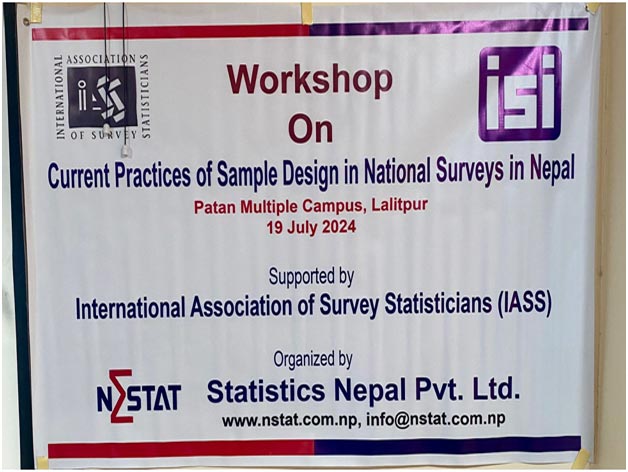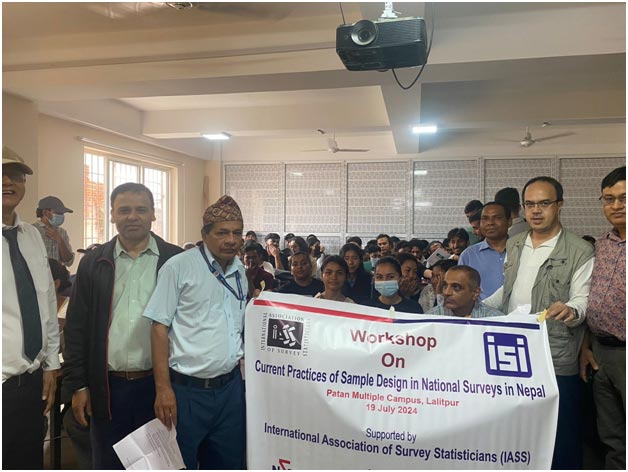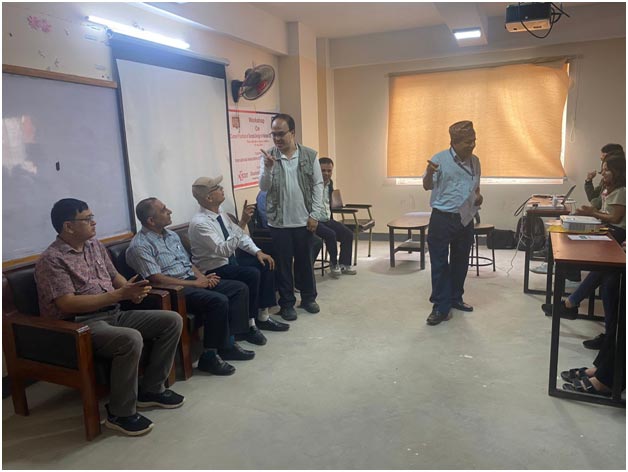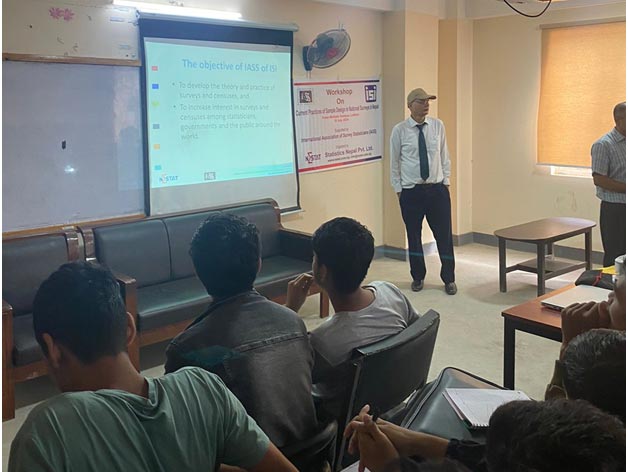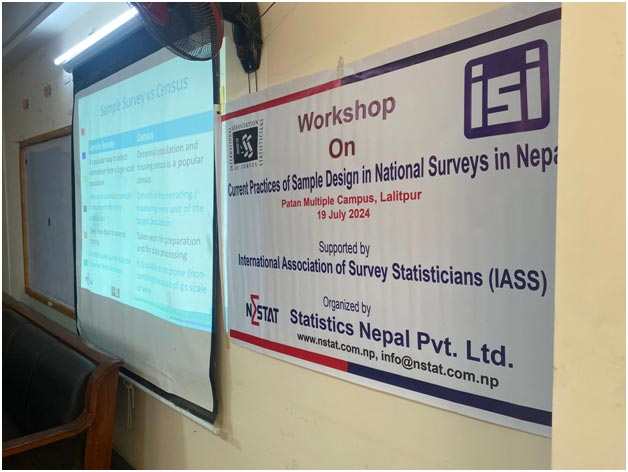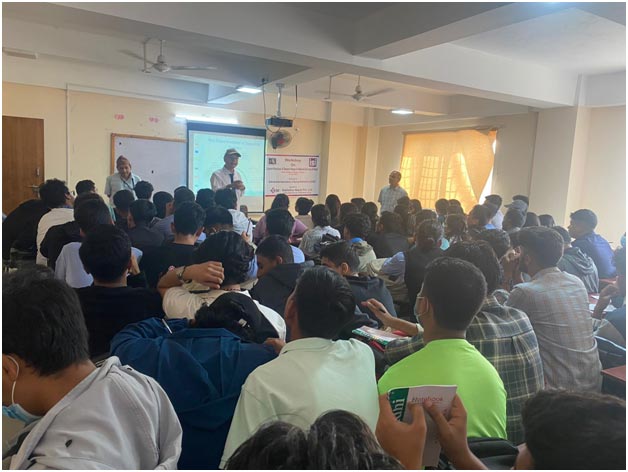International Association of Survey Statisticians (IASS) And Statistics Nepal Pvt. Ltd. (NSTAT) Workshop on Current Practices of Sample Design in National Surveys in Nepal
Date and Time:
Friday 19 July, 2024
Location:
Statistics Department, Institute of Science and Technology
Patan Multiple College, Lalitpur
Tribhuvan University
Website: nstat.com.np
Emailinfo@nstat.com.np
Workshop Objective
The main objective of the workshop is to develop the capacity of university students and teachers in sampling design for national surveys in Nepal. The National Statistics Office, along with international and national organizations, conducts large national surveys such as the Nepal Living Standard Measurement Survey, Nepal Labor Force Survey, Nepal Distributive Trade Survey, and Nepal Tourism Surveys, and disseminates the results at the national level. Students are often not aware of these activities. By the end of the workshop, students and teachers will understand how sampling methodologies are used to conduct national surveys.
Program
06:30 AM – 07:00 AM: Registration and Welcome Tea
07:00 AM – 07:15 AM: Opening Ceremony
- Welcome Address: Dr. Jishnu Mohan Bhattarai, President, Statistics Nepal Pvt. Ltd.
- Keynote Speech: Head of Department of Population Studies [Name will be finalized], [Patan Multiple College]
7:15 AM – 08:45 AM: Session 1: Overview of Sample Design in National Surveys such as Nepal Living Standard Measurement Survey (NLSS)
- Speaker: Mr. Rishi Ram Sigdel & Mr. Devendra Karanjit, [Directors, National Statistics Office]
- Topics Covered: Importance of Sample Design, Historical Context, and Current Practices, Stratified Sampling, Probability Proportional to Size (PPS), and Multi-stage Sampling used in NLSS
08:45 AM – 09:00 AM: Tea Break
09:00 AM – 10:00 AM: Session 2: Methodological Approaches in National Surveys in Nepal Distributive Trade Survey
- Speaker: Dr. Jishnu Mohan Bhattarai [President, Statistics Nepal Pvt. Ltd.]
- Topics Covered: Sample Size determination, PPS sampling, Stratification method
10:00 AM – 11:00 AM: Session 3: Sample Design in Nepal Domestic Tourism Consumption Survey
- Speaker: Jhabindra Prasad Pandey [Ministry of Poverty] & Dr. Jishnu Mohan Bhattarai, [President, Statistics Nepal Pvt. Ltd.]
- Topics Covered: Sample size determination for provincial and national estimate, Two-stage sampling etc.
11:00 AM – 11:15 AM: Closing Remarks [Assistant Campus Chief]
11:15 AM – 12:00 PM: Food and Refreshments
A summary report
On
One day workshop on Current Practices of Sample Design in National Surveys in Nepal
Jointly organized
By
Statistics Nepal Pvt. Ltd. and International Association of Survey Statisticians
At
Patan Multiple College, Lalitpur
Tribhuvan University
Nepal
Date and Venue
One day workshop was held at Patan Multiple College, Lalitpur, under Tribhuvan University, Nepal on July 19, 2024. This college offers both Bachelor'sin Statistics and Bachelor’s in Computer Science and Information Technology under the Institute of Science and Technology. It was well attended and bought together 90 participants including the teachers and students.The workshop was exciting and lively.
Purpose of the workshop
While the curriculum covers the theoretical aspects of sample design in surveys, practical experience with national survey data is limited for most students. Therefore, this workshop aimed to bridge this gap by providing hands-on experience and highlighting the importance of national surveys conducted by the National Statistics Office.
The specific objective of the workshop are as follows:
- To share the sampling practices used by NSO
- To enhance the capacity of participants to effectively design, implement, and analyze sample surveys
- To provide the form of assistance that support the IASS membership attendance at the event
Welcome Remarks in the Workshop on Sample Design in National Surveys
Dr. Jishnu Mohan Bhattarai and the Chief of the Department of Statistics at Patan Multiple College addressed the welcome session of the workshop. Dr. Bhattarai highlighted the national surveys conducted by both the government and the private sector in the nation. He welcomed all students to the sample design workshop and emphasized the contributions of the International Statistical Institute and the International Association of Survey Statisticians in developing the theoretical and practical aspects of surveys and censuses worldwide. He also thanked the IASS for supporting the workshop.
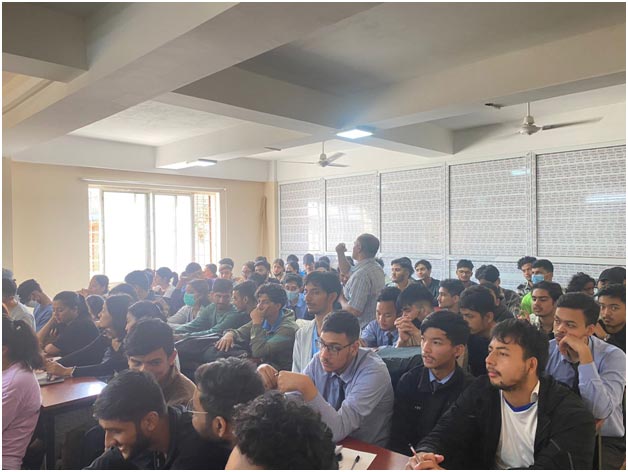
Dr. Bhattarai mentioned that students would benefit from both national and international exposure related to statistics and data through this workshop. Additionally, he noted that by the end of the workshop, students would learn how to use R software for sample allocation in strata.
The Head of the Statistics and Computer Science Department, Mr. Prakash Bahadur Amatya, also addressed the welcome session, encouraging students to learn as much as possible from the workshop. He emphasized that the workshop would be a milestone for students in understanding the practical aspects of sample design in national surveys. The welcome session concluded with tea and coffee service.
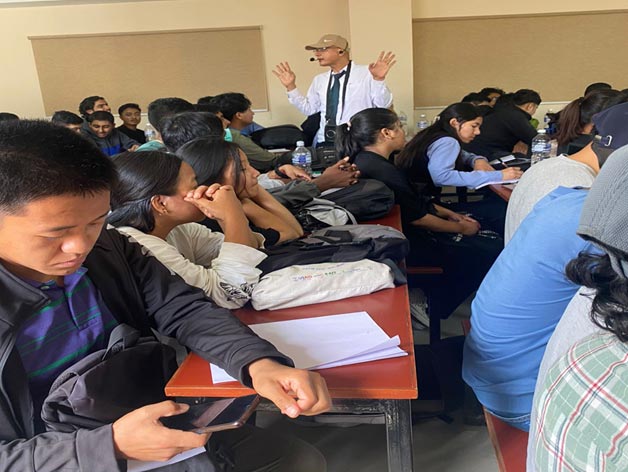
First Session: Presentation of theory of sample design
The first session was presented by Mr. Jhabindra Prasad Pandey from the Ministry of Health. He discussed the importance of sampling in estimating population characteristics. He emphasized that studying an entire population is often impossible and impractical due to size, cost, and time constraints. Sample surveys are a fast and cost-effective way to collect information on a large scale. He noted that data quality from surveys is generally better than from censuses if the survey is of a manageable size. Survey precision from probability sampling can be measured, allowing for statistical conclusions with confidence.
Mr. Pandey outlined the key steps involved in the sampling process and discussed various types of sampling, including probability and non-probability sampling, as well as restricted and unrestricted sampling, illustrated with a rectangular graph. He explained the different methods of probability sampling (e.g., simple random sampling, systematic sampling, stratified sampling, cluster sampling, and multistage sampling) and non-probability sampling (e.g., convenience sampling, voluntary sampling, purposive sampling, snowball sampling, and quota sampling).
Second Session: Sample Design in Nepal Domestic Tourism Consumption Survey, 2024
Dr. Jishnu Mohan Bhattarai, President of Statistics Nepal Pvt. Ltd., began his presentation by expressing gratitude to Prof. Dr. Natalie Shlomo, President, and Prof. ParthaLahiri, President-Elect of the International Association of Survey Statisticians (IASS), for their support. He also extended his thanks to the Department Chief and Prof. Bidur Nepal of Patan Multiple College for their initiative in organizing the workshop at their college. Additionally, he expressed his appreciation to Statistics Nepal Pvt. Ltd. for organizing such an important workshop in the country.
Dr. Bhattarai discussed the importance of scientific sampling procedures, emphasizing their critical role in ensuring the collection of high-quality, reliable data for policy making, economic analysis, and social research. He had mentioned the importance of establishment of IASS by ISI. The main objective of the IASS is to develop the theory and practices of surveys and censuses.

Dr. Bhattarai discussed the importance of statistical methods in supporting survey cycle. The frame development is the first and foremost important in sample method before sample design. National Statistics Office play a great role in frame development of households and establishments through the censuses. National Economic Census provides the sampling frame for establishments.
The minimum sample size for the survey is 385 and it will increase according to the number of domains. He discussed the difference in Probability Proportional to Size (PPS) and power allocation. He had mentioned two sampling procedure was adopted in Domestic Tourism Survey. First, the Enumeration Area (EA) was selected from the strata and at the second stage household was selected to find expenditure made by household in tourism trip. The sample size was determined in this way:
- where,
n= Sample size, z= level of confidence, p= proportion of population, if unknown we take 0.5, q= (1-p), e= margin of error (precision), a= adjusted factor. - Minimum sample size (n)= (1.96*1.96*0.5*0.5)/(0.05*0.05)
(3.8416*0.25)/0.0025=384.15~385
The country was divided into 8 domain and ultimate sample size was 8*385~5328. If 12 households were managed to select from each EAs (Primary Sampling Units) using the systematic random sampling then there will be 444 EAsthroughout the country for tourism survey.
111 EAs will be selected for each season in four seasons. 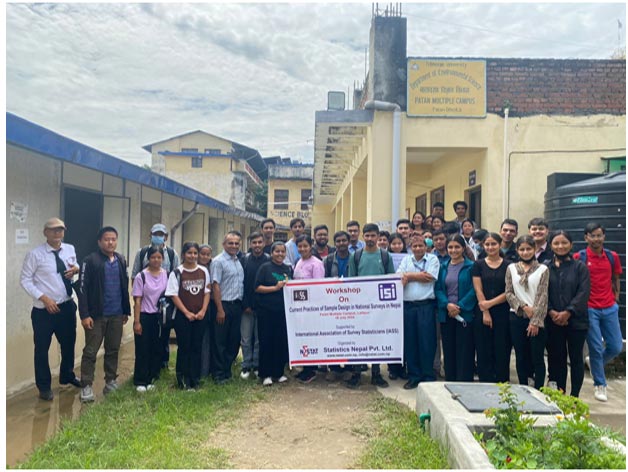
Statistics and Computer Science Students, Patan Multiple College
National Statistics Office has purposed this survey in this Fiscal Year starting from July 2024, to compile data for ten tables of Tourism Satellite Accounts. The survey aims to gather national and provincial data on domestic tourism consumption, with a focus on individuals above the poverty line who are assumed to travel more for domestic tourism. A national representative sample was selected from 8 domains, including province-wise rural, urban areas, and the Kathmandu Valley. The survey will enumerate 444 Census Enumeration Areas (Primary Sampling Units) across four seasons, with 111 PSUs each season.
Dr. Bhattarai haddemonstrated the drawing the households from 444 EA using R software.
Third Session: Nepal Distributive Trade Survey, 2022
Dr. Bhattarai and Mr. Jhabindra Prasad Pandey began the presentation of sample design adopted in the Nepal Distributive Trade Survey (NDTS). NDTS was conducted in 2022, based on the sample frame obtained from National Economic Census, 2018 (NEC). Distributive trade refers to wholesale and retail trade, which can be defined as an activity comprising purchase of goods and their disposal by way of sale without physical transformation of goods.The second DTS wasconducted in Nepal in 2022, covering all the establishments engaged in trading activities as classified under the "Section G:Wholesale and retail trade; repair of motor vehicles and motorcycles". Division G is the second largest sector of the Nepalese economy covering almost 16% of the GDP(as per 2022/23). The three group in ISIC in Section G are:
- Division 45 : Wholesale and retail trade and repair of motor vehicles and motorcycles ( 4 Groups and 4 Classes)
- Division 46: Wholesale trade, except of motor vehicles and motorcycles
( 7 Groups and 14 Classes)
- Division 47: Retail trade, except of motor vehicles and motorcycles
( 9 Groups and 25 Classes)
- Total : 3 Divisions, 20 Groups and 43 Classes
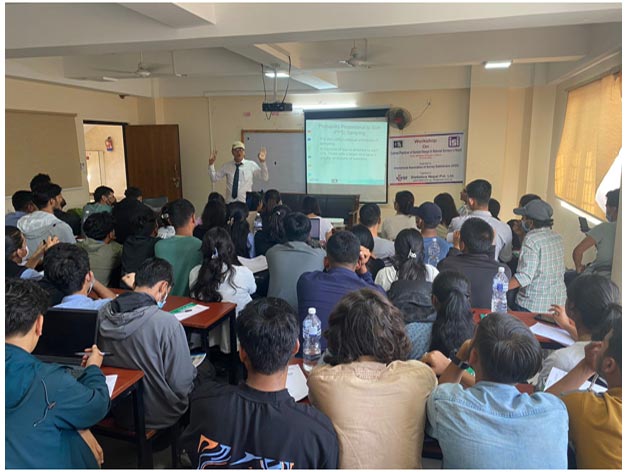
Sampling procedure in Nepal Distributive Trade Survey
This census identified 498,058 trade establishments, which were categorized into four groups based on the number of persons engaged for the sampling purposes.They are: 1-2 persons engaged, 3-5 persons engaged, 6-9 persons engaged and 10 or more persons engaged. The NDTS employed a mixed-method approach:

There was complete enumeration and sample survey in NDTS. Trade establishments with 10 or more persons engaged, and those with less frequent activities in each province, were completely enumerated.
Sample Survey: A sampling method was used for the remaining establishments after the complete enumeration. Out of the total 498,058 trade establishments, complete enumeration was conducted for 2,191 establishments with less frequent ISIC activities and fewer than 30 establishments in each province. Additionally, complete enumeration was carried out for 5,636 establishments, while a sample survey covered 12,364 establishments selected from the remaining 492,422. In total, 18,000 trade establishments were surveyed out of the 498,058 trade establishments. Dr. Bhattarai demonstrated the sample design of these 18,000 trade establishments and the practical aspects of drawing the sample from each three-digit category of the Nepal Standard Industrial Classification using R software.
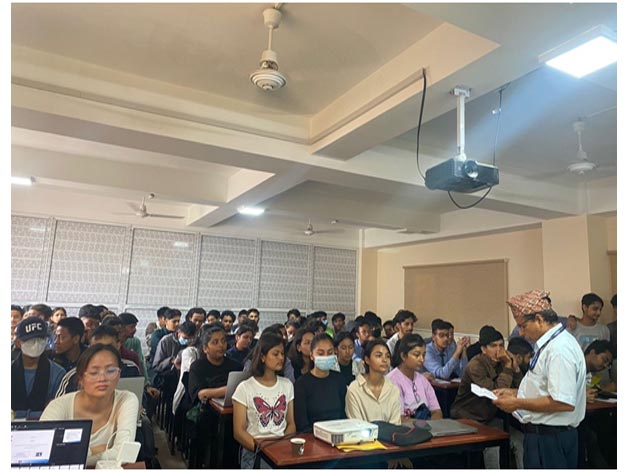
Closing of Workshop
The Assistant Campus Chief, Mr. Krishna Bahadur Mahat, thanked the IASS and Statistics Nepal Pvt. Ltd. for organizing such an important workshop at his campus and officially closed the event.
Date of Workshop
The workshop was conducted on July 19, 2024, starting at 7:00 AM.
Mode of Workshop
The workshop was conducted in person, face-to-face.
Program
06:30 AM – 07:00 AM: Registration and Welcome Tea
07:00 AM – 07:15 AM: Opening Ceremony
- MC. by Prof. Bidur Nepal
- Welcome Address: Dr. Jishnu Mohan Bhattarai, President, Statistics Nepal Pvt. Ltd.
- Keynote Speech: Head of Department of Statistics and Computer Science [Mr. Prakash Bahadur Amatya, Patan Multiple College]
7:15 AM – 08:45 AM: Session 1: Overview of Sample Design in National Surveys
- Speaker: Mr. Jhabindra Prasad Pandey [Director, Ministry of Health]
- Topics Covered: Importance of Sample Design, Historical Context, and Current Practices, Stratified Sampling, Probability Proportional to Size (PPS), and Multi-stage Sampling used in NLSS, NLFS etc.
08:45 AM – 09:00 AM: Break
09:00 AM – 10:00 AM: Session 2: Methodological Approaches in National Surveys such as Nepal Domestic Tourism Consumption Survey, 2024
- Speaker: Dr. Jishnu Mohan Bhattarai [President, Statistics Nepal Pvt. Ltd.]
- Topics Covered: Sample Size determination, PPS sampling, Stratification method, R software
10:00 AM – 11:00 AM: Session 3: Sample Design in Nepal Distributive Trade Survey, 2022
- Speaker: Dr. Jishnu Mohan Bhattarai [President, Statistics Nepal Pvt. Ltd.]
- Topics Covered: Sample size determination for provincial and national estimate, Two-stage sampling etc., Mixed approach of sampling, censuses and survey, R software
11:00 AM – 11:15 AM: Closing Remarks [Mr. Krishna Bahadur Mahat, Assistant Campus Chief]
11:15 AM – 12:00 PM: Food and Refreshments
Summary of the Workshop
The National Statistics Office, along with international and national organizations, conducts large national surveys such as the Nepal Living Standard Measurement Survey, Nepal Labor Force Survey, Nepal Distributive Trade Survey, and Nepal Tourism Surveys, and disseminates the results at the national level. Students are often not aware of these activities.
The workshop was highly beneficial for both students and teachers, highlighting the importance of national surveys and demonstrating the methodologies used by the National Statistics Office. Participants gained valuable insights into the practical aspects of sample design, which will enhance their academic and professional pursuits in the field of statistics and survey methodologies.
-End-
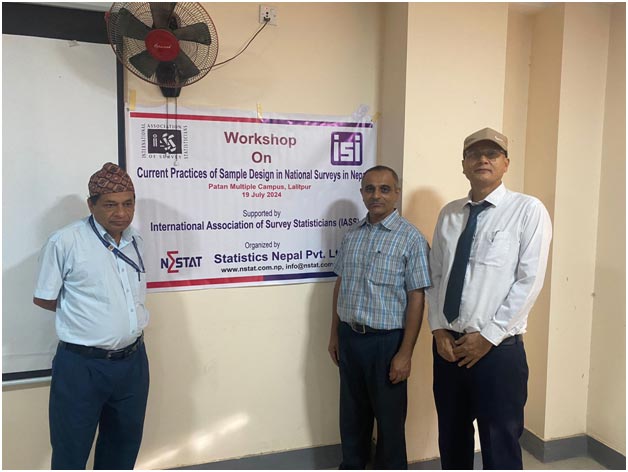
Dr. Jishnu Mohan Bhattarai [NSTAT], Prof. Bidur Nepal, [Patan Multiple College], Mr. Jhabindra Prasad Pandey [Ministry of Health] from Right
